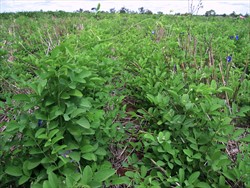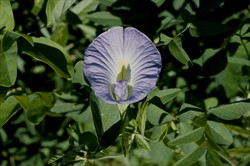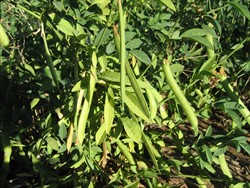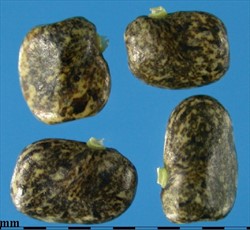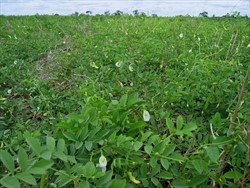Clitoria ternatea
Tropical Forages
Clitoria ternatea L.
Clitoria albiflora Mattei; Clitoria bracteata Poir.; Clitoria mearnsii De Wild.; Clitoria tanganicensis Micheli; Clitoria zanzibarensis Vatke
Family: Fabaceae (alt. Leguminosae) subfamily: Faboideae tribe: Phaseoleae subtribe: Clitoriinae.
Perennial climbing, scrambling or trailing herb with a strong, woody rootstock. Main stem suberect to erect, somewhat woody at base; secondary stems fine, twining, sparsely pubescent or glabrescent, 0.5‒3 m long. Leaves imparipinnate with 2‒3 (‒4) pairs of leaflets and a terminal leaflet; petiole 1.5‒3 cm long; stipules persistent, narrowly triangular, (1‒) 2‒5 (‒6) mm long, subulate, prominently 3-nerved; rachis 1‒7 cm long; stipels filiform, to 2 mm long; petiolules 1‒2 mm long; leaflets elliptic, ovate or nearly orbicular, 1.5‒5 cm long, 0.3‒3 cm wide, apex acute or rounded, often notched (emarginate), usually mucronate; base cuneate or rounded; both surfaces sparsely appressed pubescent, sometimes glabrous. Flowers axillary, single or paired; pedicles 4‒9 mm long, resupinate; bracteoles persistent, 4‒12 mm long, broadly ovate or rounded with obvious reticulate veins; calyx 5-lobed, lobes lanceolate, 1.5‒2.2 cm long with a few fine hairs; corolla white, pink, mauve, light blue to dark blue; tube campanulate, 0.8‒1.2 cm long; lobes triangular or oblong, 0.7‒1 cm long, acute or acuminate; standard obovate, funnel-shaped, 2‒5.5 cm long, 2‒4 cm wide, notched or rounded at apex, white and pale yellowish-green centre, a few fine hairs at apex; wings and keels much shorter than standard. Pods linear-oblong, flattened, 4‒13 cm long, 0.7‒1.2 cm wide, margins thickened, style persistent forming long beak, legume surface glabrous or sparsely pubescent when mature, pale brown, dehiscent when dry; 6‒10 (‒11) seeds/pod. Seeds oblong, somewhat flattened, 4.5‒7 mm long, 3‒4 mm wide, dark brown to almost black, shiny, often mottled, minutely pitted, strophiole obvious; 20,000‒30,000 seeds/kg.
Africa: mazerion hidi, baslat el-zuhoor, buzrula (Arabic); famehifary, vahimafoaky, velonasoa (Madagascar); caleen-koris, fiit fiite (Somalia)
Asia: rum'choan (Cambodia); 蝶豆, 蝴蝶花豆, die dou, hu die hua dou (China); bunga biru, kembang telang (Melayu), bunga temen raleng (Bugis), kembang teleng (Jawa), kembang telang (Sunda)(Indonesia); 'ang s'an dam, bang s'an dam (Laos); bunga biru, kacang telang, pokok telang (Malaysia); kolokanting, pokindong (Tagalog), giting princesa (Bikol), balog-balog (Visaya), pukinggan (also applied to Centrosema molle)(Philippines); moglaigidi (Saudi Arabia); อัญชัน, anchan (Thailand); bông biếc, chi đậu biếc, đậu biếc (Vietnam)
English: Asian pigeon wings; bluebell-vine; butterfly-pea (Australia); blue-pea, cordofan-pea, Darwin pea, kordofan pea, pigeon wings, queen's shoe
Europe: blomtsji die kokaliesji, boontsji palooma, jamaani tobaako (Caribbean Dutch), kittelbloem (Dutch); blaue Klitorie (German); clitorie, honte, lentille sauvage, liane madame, liane polisson, liane ternate, pistache marrone bleue, pois hallier, pois marron, pois-pois, pois sauvage, pois savane, pois tonnelle, pois-tonnelle (French); himmelsärt (Sweden); mavi kelebek sarmaşığı (Turkey)
Indian subcontinent: aparajita (Bengali, Punjabi, Hindi, Oriya); aparajit, aprajita, gokarni, kajina, kalina, kalizer, kava-thenthi, kavathenthi, khagin, khagtu, kowa, koyalri gokarna, koyala, shobanjan, wowatheti (Hindi); dintena, శంఖపుష్పం (Telugu); kakkanam, karuttappu, minni, sangu poo, sangu pushpam, shankapushpam, ശംഖുപുഷ്പം (Malayalam, Tamil); गोकर्णी, gokarni (Marathi); ଅପରାଜିତା (Oriya); girikarnika, kokilaa, vishnukranta, yonipushpa (Sanskrit); mezereon (Unaani); girikarniballi (Kannada); garnee (Gujarati); titaly matar; katarodu-wel, kataroluvel, nil-katarodu (Sri Lanka)
Latin America: clitória-azul, clitoria de flor azul, cunhã, ervilha-borboleta, fava do bramane, feijão-borboleta, feno de cunhã, ismênia, piquita de cunhã (Brazil); azulejo, bandera, bejuco de conchitas, campanilla, campanita, choroque, conchita azul, conchita por nuestras tierras, conchitis, cuña, deleite, diversión de los caminantes, divierte sabanerón, lupita, papito, pito de parra, totico, yuca de ratón, zapotillo de la reina, zapatico de la virgen, zapatillo de la reina (Spanish)
Pacific: kau yalewa, latoela, nawa (Fiji); 'thoua keo (Hawaii); bukike, bukike paokeke, capa de la reina, kapa de la raina, paokeke, putitainubia (Mariana Is); kles (Palau); paipa (Tonga)
There are various schools of thought on the origin of C. ternatea, some preferring tropical Asia and others tropical America. However, it has become so widely distributed throughout the tropics over the centuries, that its native distribution is now obscure. The specific epithet is in reference to the Island of Ternate, an island in the Maluku Islands (Moluccas) of eastern Indonesia, considered by Linnaeus as native territory. Regardless of native origin, it is today pantropical thanks to naturalization from human cultivation.
Forage
Used for short and medium-term pastures for grazing or cut-and-carry and as a protein bank. Makes good quality hay but difficult to handle due to its viny nature.
Environment
Used as green manure, cover crop or ley pasture for soil conservation and fertility improvement in grain cropping systems (maize, sorghum, wheat) and as a revegetation species on coal mine waste in subhumid central Queensland, Australia. Also used as a cover crop under coconut in southern India and in rubber in Malaysia.
Other
Widely planted as an ornamental on fencerows or trellises. Various parts of the plant are used for medicinal purposes in many cultures, treating a wide range of conditions. Young pods and leaves are eaten as a vegetable, and flowers and leaves are used to colour food and drink.
Occurs in grassland, open woodland, bush, riverine vegetation, and disturbed places throughout its natural range.
Soil requirements
Adapted to a wide range of soil types (from sands to heavy clays) of at least moderate fertility but is extremely well adapted to heavy clay alkaline soils, and suited to those clay soils which are too shallow for leucaena (Leucaena leucocephala). Can be grown in soils with pH from 5.5 to 8.9 but is best adapted in the pH range of 6.5‒8.0. Some tolerance of salinity, but lower than that of siratro (Macroptilium atropurpureum).
Moisture
Requires summer rainfall of 500 mm over 3 months but grows best between 700 and 1,500 mm AAR. Drought tolerant and will survive in years which have only 400 mm rainfall and a dry season of 5‒6 months or longer even if heavily grazed. Some tolerance of short term flooding but not prolonged inundation or waterlogging .
Temperature
Butterfly pea is essentially a plant of the humid and subhumid tropical lowlands at elevations from sea level to around 1,600 m asl. However, it will produce warm (wet) season growth up to 2,000 m in equatorial Africa, and at latitudes as high as 26º S. Tolerates average daily temperatures down to 15 ºC but not suited to districts with severe or frequent frosts. In areas with very cold winters and hot summers, it is grown as an annual. Production is limited more by low average daily temperatures or a short growing season than by light or even heavy frosts. Will regrow from stems following light frost or from the plant base after heavy frost. Regeneration after frost is more likely where there are established mature woody plants.
Light
Normally grown in full sunlight but moderately shade-tolerant, being used as a cover crop in coconut plantations and under rubber.
Reproductive development
Flowers can develop in 4‒6 weeks after sowing and plants continue to flower while temperature and moisture are adequate. Flowering can occur throughout the year given sufficient soil moisture and frost-free conditions. Of 58 accessions sown in January at 19º S, first flowering occurred 7‒11 weeks after sowing. Subsequent flowering events overlapped pod set and fill. Mature plants flower in summer and continue through to autumn. Predominantly self-fertile but with some out-crossing.
Defoliation
Tolerant of heavy rotational grazing, but not constant heavy defoliation. Frequent trampling by cattle will damage the stems. Growing tips and axils of stems must be left to develop new leaves. Because of its high palatability it is better managed as short-term pasture under rotational grazing. Optimum cutting interval of 56 days at heights of 5 or 10 cm for total yield of DM and protein.
It has persisted for 14 years and spread under heavy dry season grazing in infertile vertisols in northwestern Queensland, Australia. For persistence, must be allowed to set seed. In protein bank, cattle should be allowed to graze for only 2‒3 hours each day.
Fire
Temperature and duration of the fire (governed by fuel load, air temperature, soil moisture and wind) will largely determine survival of butterfly pea after fire. A hot fire has the ability to kill plants completely. Cooler fires may kill some stems, or all above ground material, in which case the plant may reshoot from surviving stems or from the plant base. Fire destroys litter, reduces cover and opens the canopy to light, which can increase the germination and establishment of both weeds and butterfly pea seedlings.
Guidelines for establishment and management of sown forages.
Establishment
Best results are achieved by planting into soil moisture (2‒6 cm), in narrow rows (15‒50 cm apart) at about 2‒4 kg/ha for long-term pastures and about 6 kg/ha for short-term pastures to achieve plant densities of 5‒10 plants/m². Excellent results can be achieved when sown as a crop using conventional planters and presswheels to achieve good soil/seed contact.
For optimum yield as a green manure crop, use a seeding rate of 12 kg/ha. As a component of grass-legume pastures, can also be planted behind a blade plough or using a "crocodile seeder". Soil temperatures between 16 and 36 ºC are required for good establishment. Weed competition will delay establishment but, once established, Clitoria can smother most weeds.
Seed should be inoculated with a broad spectrum cowpea strain rhizobium such as Tropical Group M (CB 756). Mechanically scarify seed with a high hard seed content (>30%) when soil conditions favour immediate germination, or use unscarified seed with a high hard seed percentage when staggered germination is desired, eg. planting behind a blade plough or when using a crocodile planter. Butterfly pea establishment is considered a much lower risk on heavy textured soils because of the large seed size and greater weed tolerance than alternatives such as leucaena (Leucaena leucocephala). Use of pre-emergent herbicide such as imazethapyr, 2‒8 weeks prior to sowing is desirable to achieve successful control of weeds during establishment in old cropping areas.
Fertilizer
Not normally used when sown on suitable soils, but P and S may be required on less fertile soils.
Compatibility (with other species)
Rapid climbing growth suggests that Clitoria will combine better with tall and tussock grasses than with creeping ones. However, vigour of the C. ternatea component is markedly reduced when grown with deep-rooted, competitive grasses such as buffel grass (Cenchrus ciliaris). It has been used as a leguminous mulch within elephant grass (Cenchrus purpureus) to improve the grass protein levels. When grown together, Clitoria increased total forage protein content and total DM without reducing yield of the grass .
Usually sown as a pure stand as short-term (2‒3 year) rotation with crops.
Companion species
Grasses: Has been grown succesfully with elephant grass (Cenchrus purpureus), and forage sorghums (Sorghum bicolor) and millets as well as Megathyrsus maximus. Also sown with pangola (Digitaria eriantha) as a pasture, and Andropogon gayanus and Dichanthium aristatum. It has been grown successfully with Cenchrus ciliarus and Chloris gayana as a revegetation species on coal mines.
Pests and diseases
Fungal leaf diseases (Cercospora, Colletotrichum, Oidium and Rhizoctonia) have been recorded in cool wet weather but rarely as a serious problem. Minor susceptibility to various leaf-eating caterpillars and grasshoppers. Most lines (variably) susceptible to root nematode Meloidogyne incognita, but not a serious problem.
Ability to spread
C. ternatea does not spread in grazed pastures due to limited seed set. However, there is some potential for spread in that pods shatter flinging seed, and seed is spread in the dung of grazing animals. Commonly C. ternatea pastures are sown as pure legume pastures and are progressively invaded by vigorous pasture grasses as soil-N levels build up.
Weed potential
Natural spread is unlikely as the plants are very palatable and seedlings do not compete well with existing vegetation.
Nutritive value
Excellent nutritive value with high protein and digestibility (up to 80%) with nitrogen concentrations of 3.0% N for leaf and 1.5% N for whole plant. Leaf had consistently low ADF (c. 20%) and high N (c. 4%) in Queensland.
Palatability/acceptability
Very palatable thus requiring grazing management to persist.
Toxicity
While seeds and roots contain chemically active substances, there have been no reports of toxicity to animals grazing top material of C. ternatea.
Feedipedia link
Dry matter
DM yields ranging from 1 to 15 t/ha/yr have been recorded, depending on growing conditions. 'Milgarra' (see Cultivars) yielded 4.2 t/ha DM after 4 months' growth. Under dryland conditions in the sub-humid tropics, ley pastures of 'Milgarra' in cropping systems generally produce 2‒6 t/ha/year DM.
Animal production
Liveweight gains of 0.7‒1.3 kg/ha/day recorded for steers grazing pure C. ternatea pastures in central Queensland, Australia. In northern Australia, cattle grazing para grass (Urochoa mutica ) and C. ternatea pasture gained 0.68 kg/head/day, a higher gain than for stylo (Stylosanthes) or centro (Centrosema) mixtures with para grass.
Diploid 2n = 2x = (14, 15), 16; largely cleistogamous (self-fertile) but some accessions are at least partially outcrossing (5‒10% outcrossing reported, segregating genotypes having been identified within natural populations. Homozygous blue and white and heterozygous blue-flowering genotypes have been identified. Some floricultural publications treat the white and blue flowered types as different species, C. ternatea and C. purpurea, respectively. Emasculation is easily performed with tweezers to make crosses, however no breeding programmes have been conducted.
Accessions have been evaluated for adaptation to cooler, sub-tropical environments and for persistence under grazing.
Hand harvest where economical; however, 700 kg/ha can be achieved by mechanical harvesting methods (direct-heading). Irregular pod maturity affects best time of harvest as some pods will have shattered while flowers and green pods are still present.
In screening trials, seedlings were shown to be susceptible to 2,4-D and 2,4-DB, moderately susceptible to acifluorfen, and tolerant of bentazone, fluazifop-butyl and sethoxydim. Bentazone (post-emergence) and imazethapyr (post-planting) are commonly used to control weeds during early establishment in northern Australia. Invading grasses may also be controlled using selective grass killers such as fluazifop or sethoxydim.
- Easy to establish, including on heavy clays and surface-crusting soils.
- Palatable and high nutritional value.
- Good for fertility restoration.
- High forage and seed production.
- Moderate tolerance of salinity and sodicity.
- Requires moderate fertility soils.
- Requires careful grazing management for persistence
- Generally requires replanting every 5‒8 years due to increasing dominance of invading grasses.
Conway, M.J., McCosker, K., Osten, V., Coaker, S. and Pengelly, B.C. (2001) Butterfly Pea - A legume success story in cropping lands of central Queensland. In: Rowe, B., Donaghy, D., Mendham, N. (eds) Proceedings of the 10th Australian Agronomy Conference, Hobart, Australia, January 2001. bit.ly/3dzvW9u
Jones, R.M., Bishop, H.G., Clem, R.L., Conway, M.J., Cook, B.G., Moore, K. and Pengelly, B.C. (2000) Measurements of nutritive value of a range of tropical legumes and their use in legume evaluation. Tropical Grasslands 34:78–90. bit.ly/2WMzAqx
Pengelly, B.C. and Conway, M.J. (2000) Pastures on cropping soils: Which tropical pasture legume to use? Tropical Grasslands 34:162–168. bit.ly/2yb8n6B
Reid, R. and Sinclair, D.F. (1980) An Evaluation of a Collection of Clitoria ternatea for forage and grain production. Genetic Resources Communication No. 1. CSIRO Tropical Agriculture, St Lucia, Australia. bit.ly/39mK9Dr
Staples, I.P. (1992) Clitoria ternatea L. In: Mannetje, L.’t and Jones, R.M. (eds) Plant Resources of South-East Asia No. 4. Forages. Pudoc Scientific Publishers, Wageningen, the Netherlands. p. 94–96. edepot.wur.nl/327785
'Milgarra' (Q 17476) Released in Australia (1991). Composite line with mixed blue and white flowers, comprising CPI 47187 (origin Sudan) and Q 7006 (origin Matão, SP, Brazil) and Australian naturalized lines, Q 17401, Q 24717, Q 24718 and Q 24719 as main components, with a number of minor components. 'Milgarra', which has no significant distinguishing morphological characters, is normally towards the upper end of the size ranges of descriptions in the taxonomic literature.
'Techuana', Mexico (1988), 'Conchita Clara' Honduras (1990), (CIAT 20692, IPNIA 1984) Origin Mexico. High yielding and drought tolerant accession originally introduced into Mexico from an Australian collection in 1968.
CPI 13844 (origin Sri Lanka) and CPI 30196 (origin S India) Selected in Western Australia. Performed well in agronomic trials in northern Western Australia. CPI 13844 produced good basal branching.
CPI 47187 (origin Sudan) and CPI 49963 (ex Brazil) Selected Queensland, Australia. Highly productive in small plots on vertisols in northeast Queensland, Australia.
CPI 49706 (ex Brazil) and CPI 61151 (origin Venezuela) Selected Queensland, Australia. Highest seed yields (1.2 t/ha) of 56 accessions grown in small plots in northern Queensland.
CPI 47187, CPI 49706, CPI 61151 Selected at Lansdown, northeast Queensland on red podzolic formed on old alluvium. Highest DM and seed production of 58 accessions. CPI 20733 (ex Kenya), CPI 29061 (= PI 227163, ex USA), CPI 49963, CPI 50973 (ex Senegal), Q 7006 (ex Brazil) equivalent DM production but lower seed production.
CPI 72531 (origin Somalia), CPI 50973, CPI 70337, CPI 37456 (ex Brazil), Q 4116 (ex Australia) and CPI 47187 Selected in NSW and Queensland, Australia. Highly productive in small plots on vertisols in subtropical, eastern Australia. Produced up to 2 times the yield of cv. Milgarra in regions with shorter growing seasons due to low temperature. CPI 47187 (origin Sudan, component of 'Milgarra') produced highest DM yield at Lansdown, N Queensland and Kununurra, NT, Australia, and highest seed yield at Lansdown.
CAZR I466, 752, 1433 and IGFR I23-1, 12-1, 40-1 Selected at Jodhpur, India. Tested as promising in arid zone, Jodhpur, India.
ILCT 249 (origin Delhi), ILCT 278 (Uttar Pradesh) Selected at IGFRI, Jhansi, India in a 2-stage evaluation of 92 accessions collected from different agro-climatic situations of tropical, sub-tropical and warm humid regions of India. Best yield and crude protein content of final 8 accessions.
MP 009, ILCA 9281, ILCA 9282 Selected in East Africa. Good persistence in semi-humid and semi-arid sites in coastal lowlands.
Note: ex = seed from institutional collection, origin = country of origin


